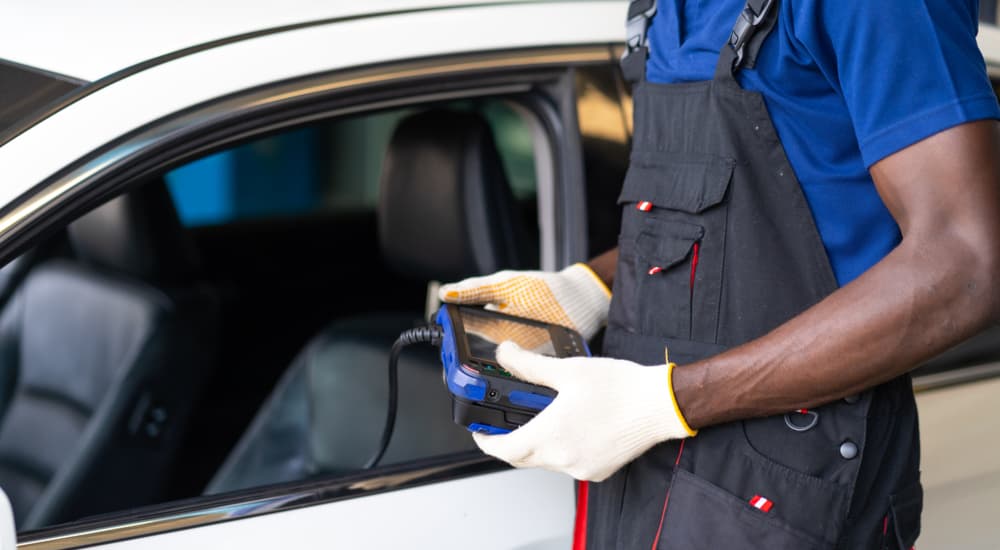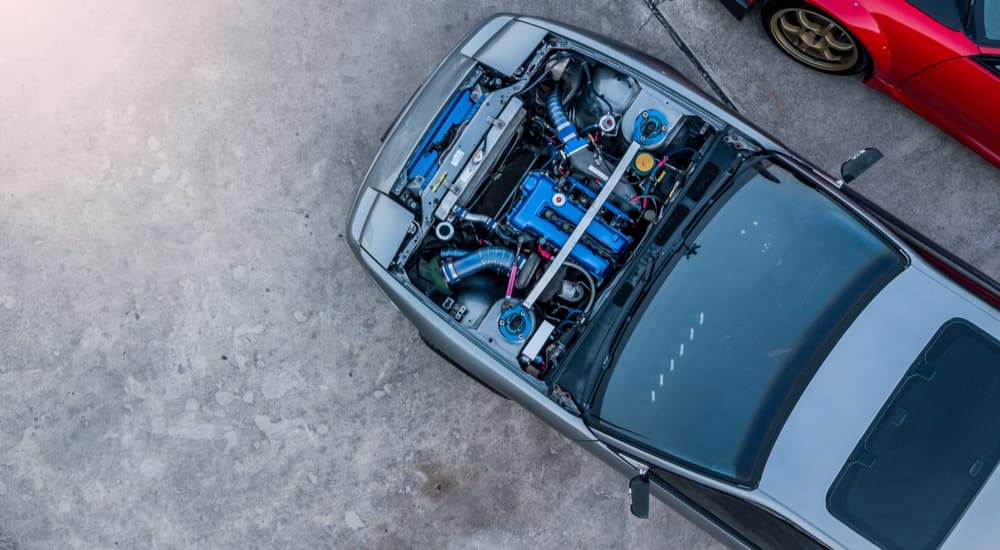As time has marched on, more and more aspects of a vehicle’s functionality are controlled electronically instead of mechanically. This goes hand in hand with the incorporation of Engine Control Units (ECUs) within a vehicle to puppeteer it all. In the late 20th century, the EPA started tightening up emission standards, leading to fuel-efficient ECU programming that tends to hinder other aspects of a vehicle’s performance, resulting in a cleaner – albeit less powerful – engine. Some gearheads sought to tweak the coding within ECUs to gain some of the vehicle’s power back, and thus flash tuning was born.
Sounds complicated, right? It is, but you don’t necessarily need an understanding of the code behind ECUs in order to manipulate it. There are plenty of devices available that can rearrange all of those 0’s and 1’s for you, and flash tuners are one such device. Unlike a custom tune, where every aspect of the vehicle is carefully measured, and the ECU reprogrammed, a flash tune can be bought off the shelf and installed without any special knowledge or equipment. This makes flash tuning the simplest ECU tuning method and is a relatively accessible way to manipulate your vehicle’s performance.
What are Flash Tuners?
To understand what flash tuners are, you have to start with a basic understanding of ECUs. ECUs are little computers of sorts that control electrical systems within the engine. They monitor and operate numerous systems from the airflow to the ignition timing to keep everything working together properly so the vehicle will run smoothly. Sensors located throughout a vehicle send information to the ECU, and it signals back instructions for how to perform in different situations.
Flash tuners are devices that can access and rewrite coding in ECUs, changing the way the vehicle’s computer communicates with all of its moving parts. Have you seen the Matrix? Of course, you have; you’re not an idiot. Flash tuners are to vehicles what Neo is to the Matrix. Vehicles can be tuned to make the engine more powerful and faster. Fast enough to dodge bullets, you ask? Well, no, probably not.

How Do You Install Flash Tuners?
Flash tuner installation couldn’t be simpler, thanks to the implementation of the standard OBD II port in vehicles. As long as your model year is post-1996, your vehicle will have an OBD II port located somewhere near the steering wheel. Flash tuners have a connector that plugs right into the OBD II port, and voilà! Installation complete. The flash tuner will provide some instructions to the operator, giving cues to turn the vehicle on and off, and after getting a read on the current ECU code, the operator can “flash” the current data, making room for new instructions to be uploaded.
What Do They Do?
Okay, so you’ve reprogrammed your ECU with some brand new software, so what happens next? Well, the vehicle will start performing based on the new parameters guiding it. This often includes altering fuel injection or ignition timing to give the engine a boost in power or re-calibrating the vehicle to operate with new aftermarket parts. In naturally aspirated engines, the performance improvements are often small, but tuning a turbocharged engine can result in significant performance gains without any physical modifications.
In the tuning world, you’ll likely see companies offer tuning products and services in the form of Stage 1, Stage 2, and Stage 3 packages. There are no specific parameters that define the different stages, so this labeling is a little arbitrary. They do (usually) follow some loose guidelines, though. Generally, a Stage 1 tuning package refers to a basic ECU reconfiguration, making minor tweaks working with whatever parts your vehicle already has. Stage 2 packages usually include some aftermarket parts and corresponding ECU tuning for even more gains. A Stage 3 package is usually the crème de la crème package with the company’s higher-end aftermarket parts and tuning included.
A Winning Combination
Upgrading the ECU is an important part of modifying a vehicle. Equally important is upgrading the parts. Altering just your ECU can certainly improve a vehicle’s performance, but it will only go so far. Manufacturers strive to have their vehicles leave the factory with ECUs that are as powerful, reliable, and efficient as they can be with stock parts, as well as high-performing in a wide variety of conditions and climates.
Significantly improving your vehicle’s performance will likely call for the inclusion of aftermarket parts, and the inclusion of aftermarket parts will likely call for tuning the ECU. They go hand in hand in the world of automotive enthusiasts – having one without the other is like having a Subaru WRX owner without a vape. The options for modifying your car are endless, but a lot of performance-enhancing modifications boil down to airflow.
The addition of forced induction (or upgrading to larger turbos with a factory turbocharger) pushes more air into the engine, which in turn allows for more fuel and more power. Upgrading the stock intake and exhaust also promotes better airflow to support the needs of an engine gobbling up more fuel and air. As you add more power, even more changes may become necessary – improved cooling, spark plugs, fuel injection, the list of potential modifications goes on and on. With some software updates, ECUs orchestrate everything to maintain a balance that won’t blow up your engine.

Tuning: A Cautionary Tale
There are a few things to consider when tuning a vehicle. If you’re a novice tuner, make sure you do your research before getting started. Tinkering with the ECU does carry the potential to cause costly damage, so make sure you know what you’re doing. Speaking of costly, tuning a vehicle can also void the manufacturer’s warranty, even though flash tuners have the ability to restore the ECU back to factory conditions. The same thing goes for insurance, depending on who your carrier is and whether or not you clue them in on modifications made to the car.
Another thing to consider is the legality of the tuning you’re considering, which will vary based on where you live. Modern ECUs make cars cleaner by effectively putting a cap on the engine’s performance. Tampering with the ECU to remove this cap may reward you with a boost of power while boosting the vehicle right over the line into the illegal zone of emission standards. This makes it important to familiarize yourself with your local emission laws before making any modifications to your engine.
A Mini Flash Tuning Dictionary
If you’re just getting started on your tuning journey, it’ll help to brush up on some jargon, so you know what the heck it is you’re talking about. Here’s some terminology you’ll encounter along the way:
- Engine Remapping: Basically another word for tuning, this refers specifically to adjust the code in a vehicle’s ECU.
- Dynamometer: Called a “dyno” for short, a dynamometer is a device used to measure rotational speed and torque. They hook up to vehicles and are used by automotive super nerds to build custom tunes.
- OBD II Port: The “on-board diagnostics” port allows access to the inner workings of a vehicle’s electrical systems, which is useful for detecting problems, tuning, and monitoring emission standards. In 1996, the United States government mandated the inclusion of the standardized OBD II port in all vehicles.
- Rich vs Lean: Rich and lean refer to different ratios of air to fuel in the engine. The air-fuel ratio where complete combustion occurs is called stoichiometric. If an engine is running rich, it has a higher ratio of gas and can create more power and a cushion against engine damage. If a vehicle is running lean, a high ratio of air is pumped into the engine.
There you have it, everything you need to know about tuning. Kidding, kidding. I did say it was a mini-dictionary, after all. The world of tuning is huge and ever-expanding as ECUs gain sophistication with each year that goes by. Tuning your vehicle is an adventure that is only limited by your imagination, and the EPA, of course.

